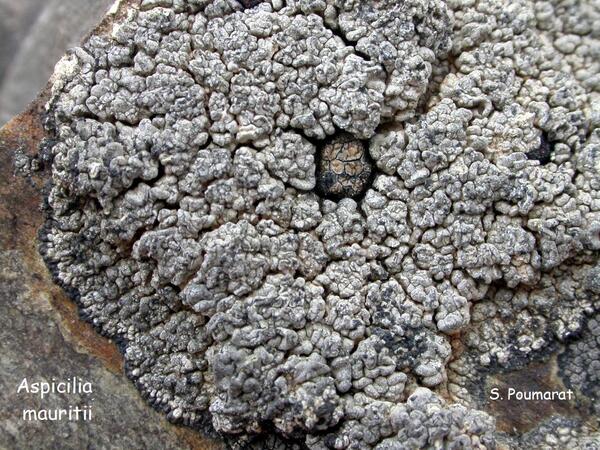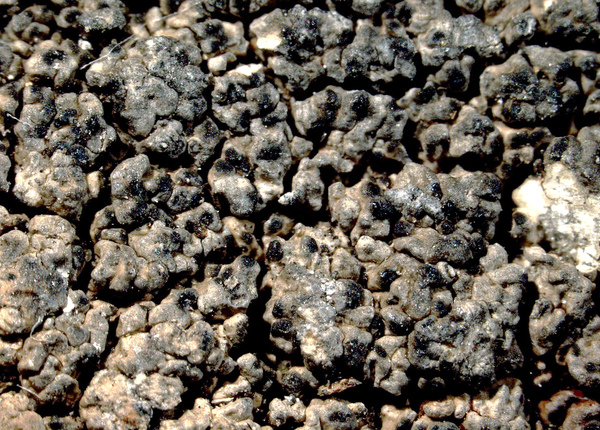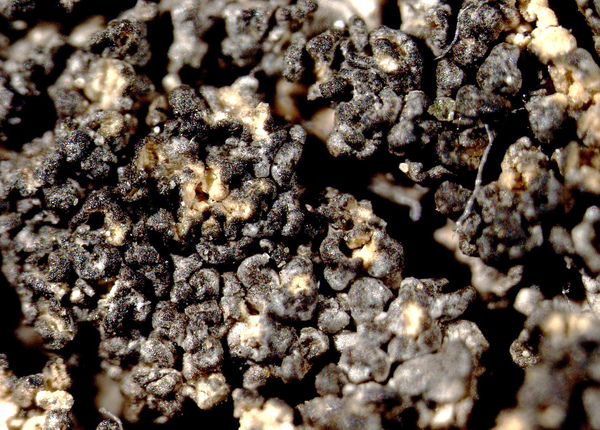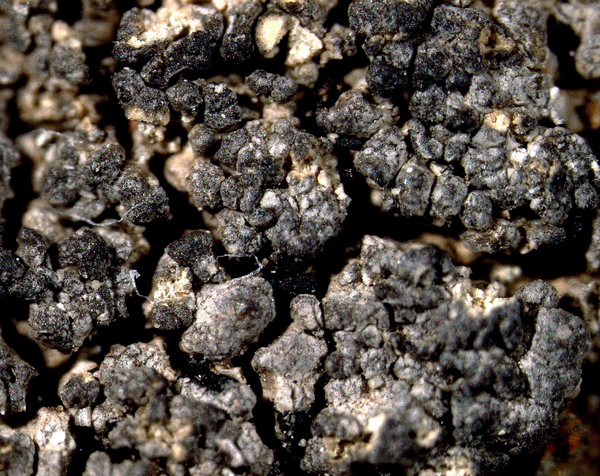Aspicilia mauritii Hue
Nouv. Arch. Mus. Hist. Nat., Paris, 5 sér., 2, 1: 32, 1912 (1910).
Synonyms: Lecanora mauritii (Hue) Zschacke
Description: Thallus crustose, episubstratic, areolate, grey to almost black, up to 1.1 mm thick, with glebulose, convex, 0.6-2 mm wide areoles, the marginal ones sometimes longer and indistinctly radiating. Surface of the areoles with irregular, angular, pointed, often suberect, isidia-like papillae. Cortex 20-40 µm thick, the uppermost part brown, with the Subdepressa-brown pigment (K-, disappearing in N); algal layer more or less continuous; medulla white, I-. Apothecia rare, aspicilioid, round to irregular-elongate, 0.3-1 mm across, with a dark brown, concave to flat disc, and a thin, slightly raised thalline margin. Epithecium brown to olive-brown; hymenium colourless; paraphyses simple or sparingly branched in upper part, submoniliform; hypothecium colourless. Asci 8-spored, clavate, the thin outer coat K/I+ blue, the wall and apical dome K/I-. Ascospores 1-celled, hyaline, broadly ellipsoid, 12-18 x 8-10 µm. Pycnidia black, immersed, with a pale wall. Conidia thread-like, straight, 16-20 x 0.7-1 µm. Photobiont chlorococcoid. Spot tests: cortex and medulla K+ yellow turning red (needle-like crystals), C-, KC-, P+ yellow-orange. Chemistry: norstictic acid, upper part of cortex with the Subdepressa-brown pigment.
Growth form: Crustose
Substrata: rocks
Photobiont: green algae other than Trentepohlia
Reproductive strategy: mainly asexual, by isidia, or isidia-like structures (e.g. schizidia)
Poorly known taxon in need of further study
pH of the substrata:
1 2 3 4 5
Solar irradiation:
1 2 3 4 5
Aridity:
1 2 3 4 5
Eutrophication:
1 2 3 4 5
Poleotolerance:
0 1 2 3
Altitudinal distribution:
1 2 3 4 5 6
Rarity
absent
extremely rare
very rare
rare
rather rare
rather common
common
very common
extremely common
Loading data...
Occurrence data
Predictive map
Growth form: Crustose
Substrata: rocks
Photobiont: green algae other than Trentepohlia
Reproductive strategy: mainly asexual, by isidia, or isidia-like structures (e.g. schizidia)
Poorly known taxon in need of further study
pH of the substrata:
| 1 | 2 | 3 | 4 | 5 |
Solar irradiation:
| 1 | 2 | 3 | 4 | 5 |
Aridity:
| 1 | 2 | 3 | 4 | 5 |
Eutrophication:
| 1 | 2 | 3 | 4 | 5 |
Poleotolerance:
| 0 | 1 | 2 | 3 |
Altitudinal distribution:
| 1 | 2 | 3 | 4 | 5 | 6 |
Rarity
absent
extremely rare
very rare
rare
rather rare
rather common
common
very common
extremely common
Loading data...
Occurrence data
Predictive map











